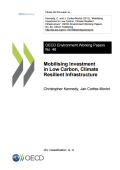
This paper addresses several broad issues for governments aiming to encourage private sector investment in low-carbon climate resilient (LCR) infrastructure, in both developed and developing world contexts. LCR infrastructure is defined, recognizing the interdependencies between infrastructure systems, and the opportunities to tackle climate change adaptation and mitigation simultaneously in national strategic infrastructure plans. Review of the performance of OECD countries in reducing greenhouse gas emissions related to three categories of gross fixed capital formation is mixed. Half of the countries analysed achieved decoupling of emissions from capital formation in the residential building sector, but only two in the transportation sector and nine in power and industry. The paper reviews future global infrastructure needs under low carbon and business-as–usual scenarios. Although cost estimates are incomplete, the technical interdependency and financial tradeoffs between infrastructure systems suggests the potential to generate virtuous cycles of low carbon growth.
As various countries explore the merits of green growth in their policies and programs, the Republic of Korea’s (ROK) transition toward green growth serves as an exemplary model.
This report examines why and how the ROK has pursued green growth as a national priority and as a development paradigm, sharing major milestones achieved in various areas such as greenhouse gas emissions, green technology, resource efficiency, and energy security. Drawing on the expertise of sector specialists and practitioners, the report highlights the processes, outcomes, and key takeaways in advancing green growth planning and implementation in the Korean context to address fossil fuel dependency, economic slowdown, and climate change. It highlights how a confluence of milestones created a strong enabling environment for green growth in the ROK, laying out the institutional, legal, and programmatic platform for green growth.
Big cities drive economic growth, 60% of global GDP is generated in only 600 urban centers. At the same time, urban areas consume more than two-thirds of the world’s primary energy and produce nearly four-fifths of all global greenhouse gas emissions (GHG emissions). In this context, mayors have to make strong arguments on economic as well as environmental aspects of green projects to foster viable greening of their cities.
This report is an attempt to provide a bridge between the published estimates of economic benefits and estimates obtained directly from cities, and the use of such estimates by decision-makers in specific settings. The report aims to provide best practice insights into the economic co-benefits of green city initiatives, how they are measured and the data and methodologies used.
Information has been gathered from selected cities and five key sectors where data is available, namely the buildings sector, public and private transportation, energy efficiency and community scale development.
Climate change creates two types of potential risks for financial institutions: physical climate risks leading to physical damage to assets, and carbon risks altering the financial viability of a part of the capital stock and business models.
This report looks at how to integrate these two risks into financial risk and valuation models and it shows that there are no fundamental barriers to this integration. In addition, it underlines that addressing this challenge requires not just a focus on the models but also risk management practices.
The green bond market - bonds whose proceeds are used for green projects, most commonly climate mitigation and adaptation projects - is growing rapidly, with outstanding issuance at US$66bn in June 2015. This growth needs to be accelerated to keep pace with the climate challenge.
This briefing paper offers a range of options for building green bond markets which ultimately will help policymakers, regulators and public financial institutions meet their infrastructure investment needs, capital market development aims, and targets for climate action and environmental protection. This paper is the first result of a partnership between the Climate Bonds Initiative, UNEP Inquiry and the World Bank Group that will produce a guide to practical options for policy makers to scale up green bond markets for sustainable development.
